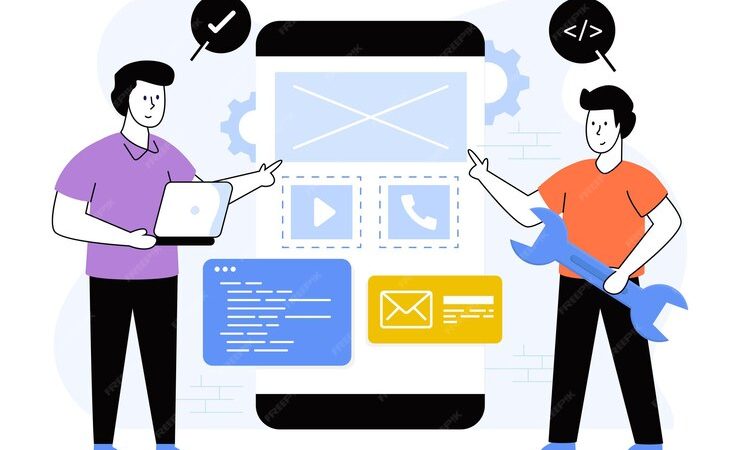6 Surefire Web Development Tips For a Seamless Site

Web Development Tips for an Outstanding Site
When it comes to website development, each of us has a different opinion of how the website should look. It could be because such beliefs are subjective – what you like maybe hideous to another.
At the same time, you must understand that half of the people consider website design a crucial factor for determining a company’s credibility, which later can influence the conversion rates, bounce rates, and more.
Your business website’s success truly depends on your website’s functionality and user experience. Ask yourself a couple of questions like:
- Can your visitors navigate the blogs?
- Can the users determine the company goals?
- Is the pricing layout simple enough for the users to understand?
- What’s the bounce rate of your website?
In case the answer is ‘no’, it could be due to your website’s design. The last thing you would want is your website visitors missing good content due to navigation issue or intricate layouts. Research shows:
- It takes only 10-15 seconds to impress your website visitors.
- You are likely to get 67% more visitors if your website is compatible with mobile devices
- 40% of the visitors leave the website if it’s not responsive
- Over 44% of website visitors leave the website with no contact details
- You may lose 47% of your visitors if your content takes more than 3 seconds to load
Considering the stats, it’s evident that your website design can:
- Set a good first impression
- Build trust and reliability
- Support SEO strategy
- Put you ahead of the competition
So, How Do I Create An Outstanding Website For My Business?
For developing and designing websites, you will come across hundreds of tips online that are either outdated or irrelevant to your requirement. Sigh, only if there were some surefire web development tips to crush your website project. Wait, there is!
Here are some practical website development tips to improve your website’s performance and increase your website traffic.
6 Must-Know Web Design & Development Tips For All

-
Draft a plan
If you believe developing a good website starts right with codes, you are entirely mistaken. Diving right into the result may be detrimental for your project. What you must do is to start with a plan.
Figure out what elements you want to include on your website. Map out your visitor’s journey and sketch out a rough plan with a probable website design. Think about the pages they would visit and the kind of content they will read and how you can convert them as customers.
Let’s say your website is about citation styles and visitors looking for MLA referencing format information; you should focus on providing sufficient information about the MLA referencing style and the MLA referencing generator.
Place yourself in place of the customer while designing. Make it about your customers. Once you understand this, you can successfully convert your leads into sales.
-
Declutter your website
Whether your website is about MLA referencing style or MLA citation machine, your website should quickly communicate the core message. After all, your visitor only wants to know the necessary information about an MLA citation generator or promptly create citations and leave.
When you are aware of your customer behaviour, it’s better to build a website that meets their needs rather than filling your web pages with unnecessary content about an MLA format generator. Remember, the less the users have to read, the better they will process content.
Hence, to retain your user’s attention:
- Break up your content and keep the critical details on the top so visitors can get the core idea instantly
- Use clear and descriptive headlines with strong words highlighting your services/products’ benefits.
- Don’t crowd the first page with excessive details. Avoid chunky paragraphs.
- Include your brand’s logo on top of the page, and provide contact information, social media integration and other brand details at the end of the page.
- ALWAYS include your primary call to action on the first page to increase your conversion rates. Make your CTA clear and visible.
- Include relevant media files, along with texts. Avoid using stock images; instead, use pictures with other people to build connections.
-
Consider visual hierarchy
Visual hierarchy is a vital design principle that determines what elements should stand out on your website. Believe it or not, the more option you give your visitors, the lesser are the chances of conversions.
Limiting options will help you lead your visitors to essential elements based on the priority. What are the crucial components of visual hierarchy?
- Element placement: The right website layout can guide your visitors to the critical sections. For example, placing your logo at the header or the CTA button at the centre of your page.
- Size and weight: Highlight and embolden your page’s principal elements, such as your brand logo and company name. Make them visually prominent, so it quickly catches your visitor’s attention before they move to the textual parts.
When your visual hierarchy is simple and straightforward, it gives your visitors a specific direction.
-
Make it easy to navigate.
Even though images, videos, and contents are the driving elements on any website, make sure not to complicate the pages. Keep in mind that your visitors are on your site with a purpose. If they don’t find the necessary information quickly, they will leave or turn to your competitors.
When your website’s readability is high, your users can effortlessly recognise the keywords or sentences and skim read. For achieving optimum readability, keep in mind these factors:
- Contrast: Your website colour scheme should contrast with your website’s elements.
- Font size: Even though you can choose your preferred font size, 16pt is the standard body text size.
- Font type: Although there are many fonts at your disposal, choose between Times New Roman and Sans serif to avoid the overwhelming effect.
- Text theme: Use clear hierarchy from large titles to small subheadings to draw your reader’s attention.
- Menu: Structure your menu according to the crucial sections, so it’s prominent and easy to navigate.
- Footer: Instead of ignoring your footer, include contact details, social media icons, or other useful links.
-
Clean code and web security
Clean code is one of the most significant factors of web development. Take the necessary precautions to avoid HTML and browser errors and follow validation standard sets.
Web security is another vital factor, primarily due to the latest security challenges. Take precautions based on the chosen language to avoid problems during the development process.
Although the preferred technology and framework ultimately depend on the target audience and budget, using the latest technology can help tom bring out the best of a project.
-
Focus on SEO and Mobile optimisation
As I have mentioned earlier, over 40% of users leave websites if they take more than three seconds to load. Not just that. The content – be it images or videos, should also load quickly.
Websites with flash-based files and heavy designs take too much time to load. Use graphics and images wherever it’s necessary. Optimise your site with high-density keywords, titles, and phrases so that your site takes the top spot on the search engine results.
Also, optimise your website for mobile devices. 80% of users access the internet from various mobile devices. Make sure your mobile website is straightforward and less cluttered. Scale down some elements and use convenient mobile features to boost your design.
Conclusion
A good website can help you build your brand identity, bring you traffic and generate revenue. Look around for some minimalistic designs and stay updated with the latest trends. Lastly, keep in mind the above-discussed factors. Whether you are a professional or amateur, these tips will help you prioritise your work while developing and designing a website.
Author bio
Robert Smith is a digital educator, and academic counsellor working on behalf of a reputable firm in United States. He is also a citation expert at MyAssignmenthelp.com through which he offers citation help in APA, MLA, and Oxford referencing style. Robret loves to read, paint, and play basketball with his friends during his free time.






